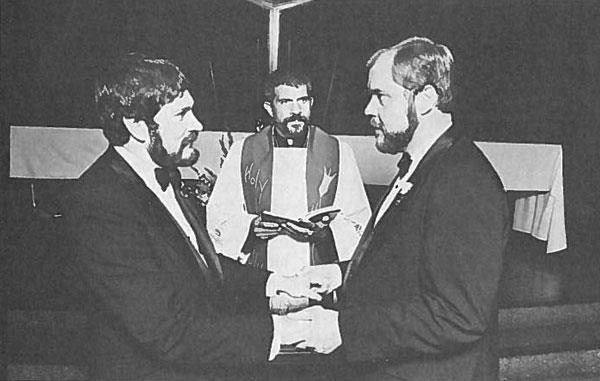Four days ago, a federal judge struck down North Carolina’s same-sex marriage ban. This ruling heralded a legal victory for the United Church of Christ, a Protestant denomination, which had sued the state for the right to marry same-sex couples. Since 2005, the UCC has affirmed its support for “equal marriage rights for couples regardless of gender.” Its lawsuit charged that the state’s DOMA legislation was an unconstitutional violation of their religious freedom.

The UCC’s victory in North Carolina has taken place against the backdrop of growing support among Mainline Protestant denominations for marriage equality. This past June, the Presbyterian Church (USA) formally voted to allow its clergy to perform same-sex marriage, thus adding another denomination to a roster of supporters that includes the Evangelical Lutheran Church, the Episcopal Church, the United Church of Christ, the Religious Society of Friends and Unitarian Universalists. Other denominations are battling issues of formal policy. The United Methodist Church recently opted to retain the credentials of two clergy who were brought under disciplinary review for performing same-sex marriage ceremonies. The Mennonite Church, also grappling with these questions for over a decade, is in the midst of a similar process. Mainline Protestants’ recent policy decisions on same-sex marriage, however, come out of a much longer history of religious debates over same-sex sexuality.
The first stirrings of a modern Christian debate over same-sex relationships followed on the heels of the so-called “medical invention of homosexuality.” The ink had hardly dried on British sexologist Havelock Ellis’s Sexual Inversion (1897), when Hugh Northcote, an Anglican clergyman, produced the first English book in Christian ethics to consider these new theories on sexuality. Christianity and Sex Problems was published in the United States in 1906 (revised edition, 1916). Northcote discussed theories of “sexual inversion” and reflected on how Christians might ethically respond to this tragic condition. He insisted that afflicted inverts must live chaste lives, but suggested that durably afflicted homosexuals might manage their condition through a same-sex partnership modeled after the Biblical duo of David and Jonathan (this model could also be found in Ellis’ own work). Such a relationship, Northcote imagined, would be affectionate and erotic, but would remain physically chaste—an arrangement that addressed “soul-needs” of the two persons without “injuring the moral life of either.”
Work by Northcote and other European authors influenced the American leaders in the hybrid field of pastoral psychology, which grew rapidly amid the heralded “Psychology Boom” after World War II. These experts also drew from psychiatric theories of disease and cure and proposed model relationships for homosexuals. Methodist minister Kimball Jones, author of Toward a Christian Understanding of the Homosexual (1966), offered a view typical of this liberal Protestant therapeutic discourse. He assumed that what was truly good about sex—its potential to foster vulnerability and inter-connection—was only possible between heterosexual spouses, whose gender difference and procreative plumbing led naturally to nuptial bliss. Homosexuals’ truncated psyches and ill fitted bodies, they assumed, did not allow comparable depths of intimacy. However, these Christian theologians were not only worried that homosexuals were missing out on the fulfillments of heterosexual marriage; they also fretted that psychiatric maladjustment might bring worse evils—further emotional damage and unrestrained promiscuity. Thus, their partial answer to this conundrum was a kind of domestic arrangement. Ideally, this relationship would be chaste. Though certainly not a good in itself, such a relationship might at least serve as a prophylactic against promiscuity and thus a stopgap to moral ruin.
At nearly the same moment, in the mid-1960s, a handful of American Protestant clergy were already beginning to question the disease theories that undergirded this pathological view of same-sex relationships. Inspired by and working alongside the homophile movement—the name given to the early lesbian and gay civil rights movement—these clergy asserted the moral good of marriage and insisted that its life-giving intimacy ought to be available to same-sex couples. In 1968, the homophile movement codified its own ideas of homosexual morality with a statement declaring that “Gay is Good.” Liberal clergy followed suit. Episcopal theologian Norman Pittenger’s influential A Time for Consent (1967) insisted that same-sex love, no less than heterosexuality, brought genuine intimacy and mutual pleasure. A series of publications and educational materials coming out of Glide Memorial Methodist Church, a hub for the 1964-founded Council on Religion and the Homosexual, published a booklet on Biblical views about homosexuality by Methodist theologian Robert Treese. This piece challenged the notion that heterosexuality was a necessary pre-condition for a healthy sexual relationship. “There is no reason,” Treese argued, “to deny the possibility of marriage to the homosexual couple.”
These clergy understood marriage as part and parcel of their moral advocacy for homosexual inclusion and many performed ceremonies of blessing for same-sex couples. Paul Jones, a Methodist minister in Kansas City who also helped support the formation of a local homophile association called the Phoenix Society, penned a strong defense of these practices after performing marriage ceremonies for two local couples. An associate minister at Glide Memorial Church recalled that he and other Glide clergy performed “covenants of friendship” for same-sex couples in the late 1960s.
It was not until the early 1970s that a new wave of gay liberation activism stressed visibility as a strategy for change. In this push for visibility, the marriage practices of Mainline Protestant clergy in cities from San Francisco to New York to Minneapolis appeared in newspaper and thus also came to the attention of the broader denominational fellowships At the same time, Troy Perry, founder of the gay-welcoming Los Angeles Metropolitan Community Church, changed the conversation by publicly declaring his own homosexuality and inviting press coverage of same-sex wedding ceremonies. Journalists across the country eagerly covered local examples of what they termed a nation-wide “Gay Marriage ‘Boom.’” It did not take long for conservatives in those denominations to mobilize in opposition.
Mainline Protestant denominations in the U.S. have waged pitched battles over marriage (and ordination) since the 1970s. Contending factions on either side of these controversies have both invoked their religious convictions as the reason for their diverging views on same-sex marriage. The recent decisions represent a tipping point in institutions that decide these matters of religious conviction, for the most part, through democratic processes similar to the American legislative system. The difference, of course, is that both sides of the disagreements are fighting for religious views. Thus, the recent policy changes around same-sex marriage in in Mainline Protestant institutions do not signal a victory, in the narrow sense, for the “rights” of same-sex couples. In these religious contexts, the truce over policy grants freedom of conscience to clergy and congregations that see same-sex marriage as vital to their theology and religious practice. Same-sex marriage, for these religious communities, is no longer about disease management or harm reduction. It is about putting religious commitments to welcome and inclusion into practice. Including same-sex couples in the liturgical rite of marriage, in other words, is about more than rights; it’s about faith.
Heather R. White is a Research Scholar and Adjunct Assistant Professor at the New College of Florida, where she teaches courses in religious studies and gender studies. She was also, most recently, a Coolidge Fellow at Auburn Theological Seminary and a Burke Scholar in Residence at the theological library of Columbia University. Heather researches and writes about religion and sexuality in twentieth-century United States and is finishing revisions to a book titled Reforming Sodom: Protestants and the Rise of Gay Rights, which will be published by University of North Carolina Press.

NOTCHES: (re)marks on the history of sexuality is licensed under a Creative Commons Attribution-NonCommercial-NoDerivatives 4.0 International License.
Based on a work at www.notchesblog.com.
For permission to publish any NOTCHES post in whole or in part please contact the editors at NotchesBlog@gmail.com






Pingback: Faith in Marriage | Public Seminar